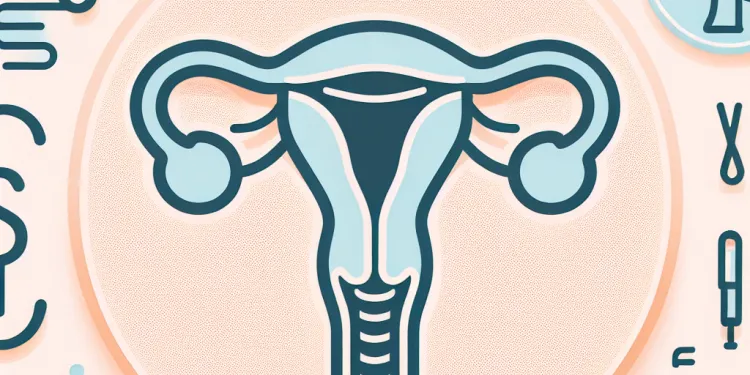
Find Help
More Items From Ergsy search
-

Can a womb lining test detect cancer?
Relevance: 100%
-

Can a womb lining test detect cancer?
Relevance: 100%
-

What is the Womb Lining test?
Relevance: 80%
-

Why is a womb lining test performed?
Relevance: 78%
-

What is the womb lining test?
Relevance: 77%
-

Why might someone need a womb lining test?
Relevance: 74%
-

Is the womb lining test covered by the NHS?
Relevance: 74%
-

How is the womb lining test performed?
Relevance: 72%
-

Is the womb lining test covered by the NHS?
Relevance: 72%
-

How is a womb lining test conducted?
Relevance: 70%
-

Is the womb lining test painful?
Relevance: 69%
-

Is a womb lining test painful?
Relevance: 69%
-

Are there risks associated with a womb lining test?
Relevance: 68%
-

What happens after a womb lining test?
Relevance: 67%
-

Is there any follow-up required after a womb lining test?
Relevance: 64%
-

Are there any risks associated with the womb lining test?
Relevance: 63%
-

Can I drive after the womb lining test?
Relevance: 61%
-

How should I prepare for a womb lining test?
Relevance: 60%
-

How long does it take to get results from a womb lining test?
Relevance: 59%
-

How long does it take to get results from a womb lining test?
Relevance: 59%
-

Does the womb lining test require any special preparation?
Relevance: 56%
-

Prostate cancer symptoms - detecting them early
Relevance: 39%
-

Can a pregnancy test detect a miscarriage?
Relevance: 38%
-

Prostate cancer diagnosis and tests
Relevance: 37%
-

How can I test myself for colorectal cancer?
Relevance: 37%
-

Do all pregnancy tests detect the same levels of hCG?
Relevance: 36%
-

Is genetic testing available for colorectal cancer?
Relevance: 36%
-

What does an evaporation line mean on a pregnancy test?
Relevance: 35%
-

How soon can a pregnancy test detect pregnancy?
Relevance: 35%
-

Can home colorectal cancer tests replace a colonoscopy?
Relevance: 35%
-

Are there risks associated with home colorectal cancer tests?
Relevance: 35%
-

What are the advantages of an at-home colorectal cancer test?
Relevance: 35%
-

How to do the FIT bowel cancer screening test | Cancer Research UK
Relevance: 34%
-

How often should I perform a home colorectal cancer test?
Relevance: 33%
-

Will insurance cover the cost of home colorectal cancer tests?
Relevance: 32%
-

Breast cancer: testing and treatment | NHS
Relevance: 31%
-

Vaginal Cancer
Relevance: 30%
-

What is a stool DNA test?
Relevance: 30%
-

Endometrial Cancer
Relevance: 30%
-

Are digital pregnancy tests more accurate than non-digital tests?
Relevance: 29%
Can a Womb Lining Test Detect Cancer?
Understanding Womb Lining Tests
A womb lining test, also known as an endometrial biopsy, involves taking a small sample of the tissue lining the uterus. This test is primarily conducted to investigate issues such as abnormal uterine bleeding or to assess the health of the endometrium. While the test is not specifically designed to detect cancer, it can sometimes identify abnormal cells or changes that may indicate the presence of endometrial cancer or pre-cancerous conditions.Endometrial Cancer Detection
Endometrial or uterine cancer begins in the lining of the uterus, known as the endometrium. It is the most common type of gynaecological cancer in the UK. Early detection of endometrial cancer often leads to more effective treatment options. A womb lining test can detect abnormalities in the endometrial cells, which may suggest cancer. If abnormal cells are found, further testing, such as imaging scans or additional biopsies, may be required for a definitive diagnosis.When is a Womb Lining Test Recommended?
Healthcare providers in the UK may recommend a womb lining test if a patient exhibits symptoms such as irregular menstrual cycles, post-menopausal bleeding, or unexplained pelvic pain. These symptoms can sometimes signal underlying issues, including potential cancer. The test is also useful for monitoring patients with known risk factors for endometrial cancer, such as obesity, hormone therapy, or a family history of uterine cancer.Effectiveness and Limitations
While a womb lining test can be a valuable diagnostic tool, it has its limitations. The test may not always detect cancer in its earliest stages or in areas not sampled during the biopsy. Additionally, factors like sampling technique and the experience of the pathologist can impact the accuracy of the results. It is crucial for patients to discuss the test's potential outcomes and limitations with their healthcare provider.Conclusion
In the UK, a womb lining test serves as a useful procedure for evaluating abnormal uterine conditions and can aid in the detection of endometrial cancer. However, it is not a standalone diagnostic tool for cancer detection. If abnormalities are detected, further exploration is necessary to confirm the presence of cancer. This highlights the importance of timely medical consultation and follow-up examinations for individuals exhibiting concerning symptoms.Can a Womb Lining Test Find Cancer?
What is a Womb Lining Test?
A womb lining test is also called an endometrial biopsy. This test takes a small piece of tissue from the inside of the womb. Doctors do this test to check unusual bleeding or to see if the womb lining is healthy. The test is not made just to find cancer, but it can show if there are strange cells. These cells might mean there is womb cancer or changes that could lead to cancer.Finding Womb Cancer
Womb cancer starts in the lining of the womb, called the endometrium. It is the most common kind of women’s cancer in the UK. Finding womb cancer early helps give better treatment choices. A womb lining test can find strange cells that might mean cancer. If strange cells are found, more tests like scans or more biopsies might be needed.When Do You Need a Womb Lining Test?
Doctors in the UK might say you need a womb lining test if you have symptoms like unusual periods, bleeding after menopause, or pain in the lower belly. These could be signs of problems, including cancer. The test is also good for watching people at risk for womb cancer. Risks include being overweight, hormone treatments, or having family members with womb cancer.How Good is the Test?
The womb lining test is helpful but not perfect. It might miss cancer in early stages or miss cancer in parts not tested. The test's success depends on how the sample is taken and the skill of the person checking it. It’s important to talk with your doctor about what the test can and cannot do.Final Thoughts
In the UK, a womb lining test is useful for checking unusual womb problems. It can help find womb cancer but cannot find cancer on its own. If the test shows something unusual, more tests are needed to be sure if it is cancer. This makes it important to see a doctor quickly if you have worrying symptoms. Also, following up with more checks is very important.Frequently Asked Questions
What is a womb lining test?
A womb lining test, also known as an endometrial biopsy, involves collecting a small tissue sample from the lining of the uterus to examine it for abnormalities.
Can a womb lining test detect cancer?
Yes, a womb lining test can help detect endometrial cancer by identifying cancerous or precancerous cells in the tissue sample.
Is a womb lining test the only way to detect uterine cancer?
While a womb lining test is a common method, other procedures like ultrasounds or hysteroscopies may also be used to diagnose uterine abnormalities.
What symptoms might prompt a doctor to recommend a womb lining test?
Symptoms such as abnormal uterine bleeding, postmenopausal bleeding, or persistent pelvic pain may lead a doctor to recommend a womb lining test.
How is a womb lining test performed?
The test involves inserting a thin tube through the cervix into the uterus to gently remove a tissue sample for analysis.
Is a womb lining test painful?
The procedure can cause some discomfort or cramping, but it is usually quick, and any discomfort typically subsides shortly afterward.
How long does it take to receive results from a womb lining test?
Results usually take a week or two, but the exact time can vary depending on the lab and healthcare provider.
Are there any risks associated with the womb lining test?
Complications are rare but can include infection, bleeding, or uterine perforation. It's important to discuss risks with your doctor.
What happens if cancerous cells are found in the womb lining test?
If cancerous cells are detected, further diagnostic testing and treatment planning will be necessary, usually involving a specialist.
Can a womb lining test detect other conditions besides cancer?
Yes, it can also detect other conditions such as endometrial hyperplasia, which is a precancerous condition, and other abnormalities.
Why might someone have a womb lining test without cancer symptoms?
A test might be recommended for those at higher risk of endometrial cancer or for those experiencing fertility issues.
Is a referral needed for a womb lining test in the UK?
Yes, typically a referral from a GP or specialist is required for this procedure.
Can a womb lining test be performed in an outpatient setting?
Yes, it is commonly performed in an outpatient setting and does not typically require an overnight stay.
Are there any preparations needed before a womb lining test?
Preparation might include avoiding certain medications, fasting, or arranging transportation if sedation is used, based on your doctor's advice.
How often should someone have a womb lining test?
The frequency depends on individual risk factors and symptoms. It's best determined by a healthcare provider on a case-by-case basis.
What is a womb lining test?
This is a simple test that looks at the inside of a woman's womb. It checks to see if the womb is healthy. The womb is where a baby grows if a woman is pregnant. The test is important for women having trouble having babies.
Tools that can help:
- Ask a doctor or nurse to explain the test in simple words.
- Use pictures or videos to understand better.
- Ask any questions if something is unclear.
A womb lining test is also called an endometrial biopsy. It means taking a tiny piece of tissue from the inside of the womb. Doctors look at this piece to check if everything is okay.
Can a test on the womb lining find cancer?
A test checks the inside layer of the womb.
It looks for signs of cancer.
Doctors use this test to help find cancer early.
Tools like picture cards can help understand more.
A test of the womb lining can find cancer or signs that cancer might start. It looks for bad cells in the tissue sample.
Is there another way to find uterine cancer besides a womb lining test?
A womb lining test is one way to check for problems inside the uterus. Other ways to check include using an ultrasound scan or a tiny camera called a hysteroscope.
When might a doctor say you need a womb lining test?
A womb lining test checks the inside of the uterus. A doctor might say you need this test if:
- You have bleeding that is not normal.
- You have heavy periods.
- You have bleeding after menopause.
- You have pain in your lower belly.
If you are unsure, ask for help. You can talk to a doctor, nurse, or someone you trust.
If you have problems like unusual bleeding from your womb, bleeding after you've stopped having periods, or constant pain in your belly, your doctor might say you should have a test of the inside of your womb.
If this sounds tricky, try these tips:
- Ask your doctor to explain new words.
- Write down what they say so you can look at it later.
- Bring someone with you to help remember things.
- Use a calendar to keep track of symptoms.
How do doctors check the inside of the womb?
Doctors check the inside of a womb to see if it is healthy.
To do this, a doctor will use a small tool to take a tiny piece from the womb lining. This does not take long.
Your doctor can explain what will happen. You can ask any questions if you are unsure.
If you feel nervous, taking slow, deep breaths can help you relax.
Bringing a friend or family member with you can also make you feel better.
The test uses a small, thin tube. The tube goes through the cervix and into the uterus. The doctor uses it to take a tiny piece of tissue. This is done carefully. The tissue is then checked to see how it looks.
Does a womb lining test hurt?
The procedure might hurt a little bit or feel like a cramp. But it doesn’t last long, and the pain usually goes away soon after.
How long do I wait to get my womb lining test results?
A womb lining test checks the inside of your womb. It helps doctors see if everything is okay.
After the test, you usually wait 1 to 2 weeks to get your results.
Here are some tips to help you while you wait:
- Ask your doctor when you will get the results.
- Write down any questions you have, so you remember to ask them.
- Talk to someone you trust if you feel worried.
- Use a calendar to mark the day you expect the results.
Remember, if you have any questions, you can ask your doctor or nurse for help.
It can take 1 or 2 weeks to get your results. But sometimes, it can be sooner or later. It depends on the lab and your doctor.
Are there any risks with the womb lining test?
Problems do not happen often, but sometimes they do. You might get an infection, bleeding, or a tiny hole in the womb. It is important to talk to your doctor about these risks.
What if bad cells are in the womb lining test?
If doctors find cancer cells, you will need more tests and a plan for treatment. This usually means seeing a special doctor who knows a lot about cancer.
Can a womb lining test find other problems, not just cancer?
Yes, it can see other problems too. It can find a problem called endometrial hyperplasia. This is when cells grow too much and might turn into cancer. It can also find other things that are not normal.
Why would a doctor check the womb lining if there are no signs of cancer?
Sometimes, doctors want to make sure everything is okay, even if there are no cancer signs. This test helps check for other problems or just to be safe.
If you're worried, you can:
- Talk to the doctor. They can explain it simply.
- Ask a friend or family member to come with you to the doctor's visit.
- Write down your questions before the visit.
A doctor might suggest a test for people who could get endometrial cancer more easily. They also might suggest it for people having trouble having babies.
Do you need to ask a doctor for a womb lining test in the UK?
Yes, you usually need a note from your doctor or specialist to have this procedure.
Can doctors check the womb lining at a clinic?
Yes, doctors can check the womb lining at a clinic. You do not need to stay in the hospital.
Doctors use a small tool to take a tiny piece of the womb lining.
It is not painful and does not take long.
If you feel nervous, you can listen to music or take deep breaths to feel calm.
Yes, this is usually done at a clinic or doctor's office. You do not need to stay overnight.
Do I need to get ready before a womb lining test?
Get ready by following your doctor’s advice. This might mean:
- Not taking some medicines
- Not eating for a while
- Having someone drive you home if you get sleepy medicine
When should you get a womb lining test?
How often you need to do this depends on how you feel and any health concerns you have. A doctor will help you decide what's best for you.
Useful Links
- Ergsy carfully checks the information in the videos we provide here.
- Videos shown by Youtube after a video has completed, have NOT been reviewed by ERGSY.
- To view, click the arrow in centre of video.
- Most of the videos you find here will have subtitles and/or closed captions available.
- You may need to turn these on, and choose your preferred language.
- Go to the video you'd like to watch.
- If closed captions (CC) are available, settings will be visible on the bottom right of the video player.
- To turn on Captions, click settings .
- To turn off Captions, click settings again.
More Items From Ergsy search
-

Can a womb lining test detect cancer?
Relevance: 100%
-

Can a womb lining test detect cancer?
Relevance: 100%
-

What is the Womb Lining test?
Relevance: 80%
-

Why is a womb lining test performed?
Relevance: 78%
-

What is the womb lining test?
Relevance: 77%
-

Why might someone need a womb lining test?
Relevance: 74%
-

Is the womb lining test covered by the NHS?
Relevance: 74%
-

How is the womb lining test performed?
Relevance: 72%
-

Is the womb lining test covered by the NHS?
Relevance: 72%
-

How is a womb lining test conducted?
Relevance: 70%
-

Is the womb lining test painful?
Relevance: 69%
-

Is a womb lining test painful?
Relevance: 69%
-

Are there risks associated with a womb lining test?
Relevance: 68%
-

What happens after a womb lining test?
Relevance: 67%
-

Is there any follow-up required after a womb lining test?
Relevance: 64%
-

Are there any risks associated with the womb lining test?
Relevance: 63%
-

Can I drive after the womb lining test?
Relevance: 61%
-

How should I prepare for a womb lining test?
Relevance: 60%
-

How long does it take to get results from a womb lining test?
Relevance: 59%
-

How long does it take to get results from a womb lining test?
Relevance: 59%
-

Does the womb lining test require any special preparation?
Relevance: 56%
-

Prostate cancer symptoms - detecting them early
Relevance: 39%
-

Can a pregnancy test detect a miscarriage?
Relevance: 38%
-

Prostate cancer diagnosis and tests
Relevance: 37%
-

How can I test myself for colorectal cancer?
Relevance: 37%
-

Do all pregnancy tests detect the same levels of hCG?
Relevance: 36%
-

Is genetic testing available for colorectal cancer?
Relevance: 36%
-

What does an evaporation line mean on a pregnancy test?
Relevance: 35%
-

How soon can a pregnancy test detect pregnancy?
Relevance: 35%
-

Can home colorectal cancer tests replace a colonoscopy?
Relevance: 35%
-

Are there risks associated with home colorectal cancer tests?
Relevance: 35%
-

What are the advantages of an at-home colorectal cancer test?
Relevance: 35%
-

How to do the FIT bowel cancer screening test | Cancer Research UK
Relevance: 34%
-

How often should I perform a home colorectal cancer test?
Relevance: 33%
-

Will insurance cover the cost of home colorectal cancer tests?
Relevance: 32%
-

Breast cancer: testing and treatment | NHS
Relevance: 31%
-

Vaginal Cancer
Relevance: 30%
-

What is a stool DNA test?
Relevance: 30%
-

Endometrial Cancer
Relevance: 30%
-

Are digital pregnancy tests more accurate than non-digital tests?
Relevance: 29%


